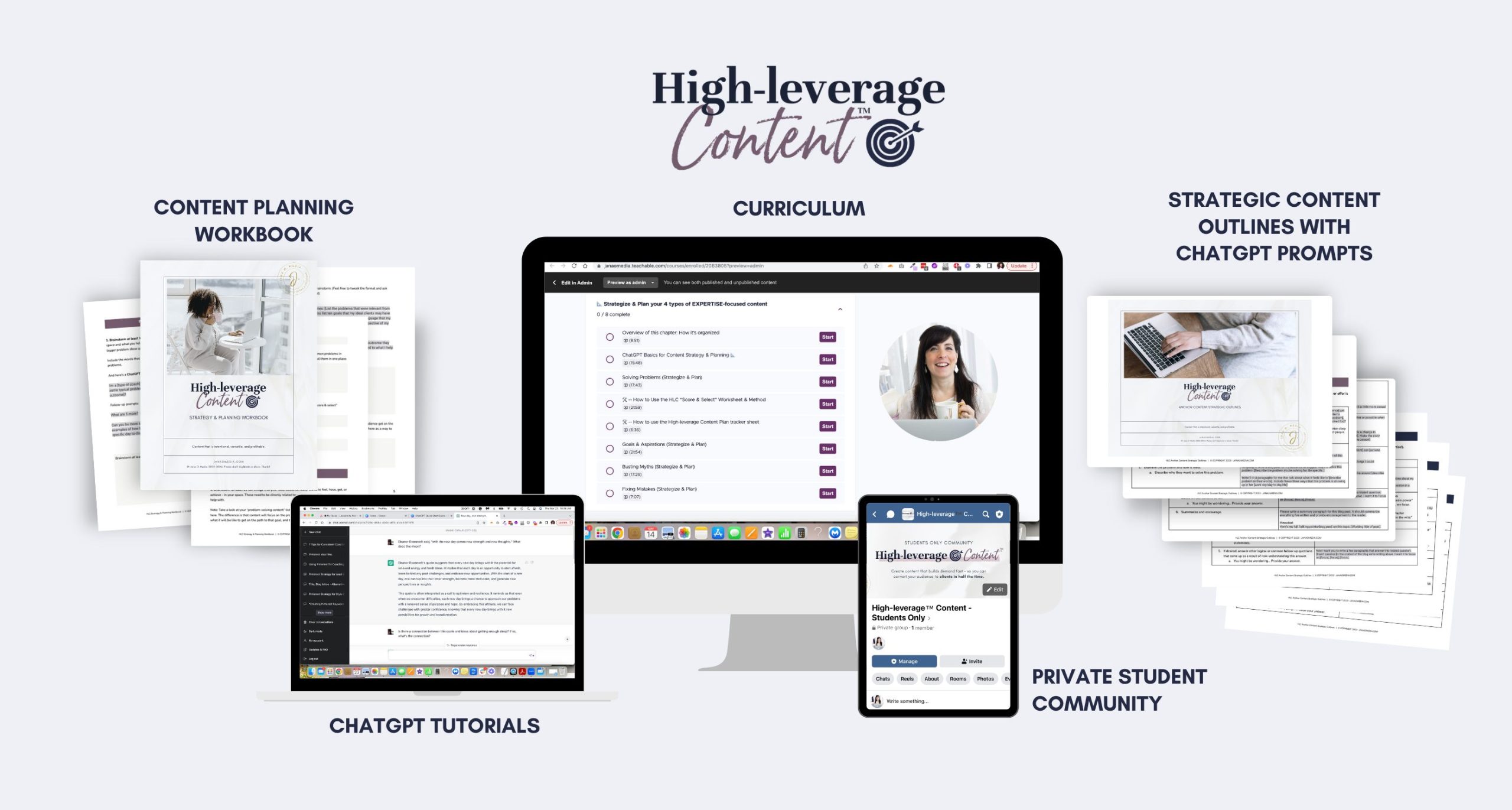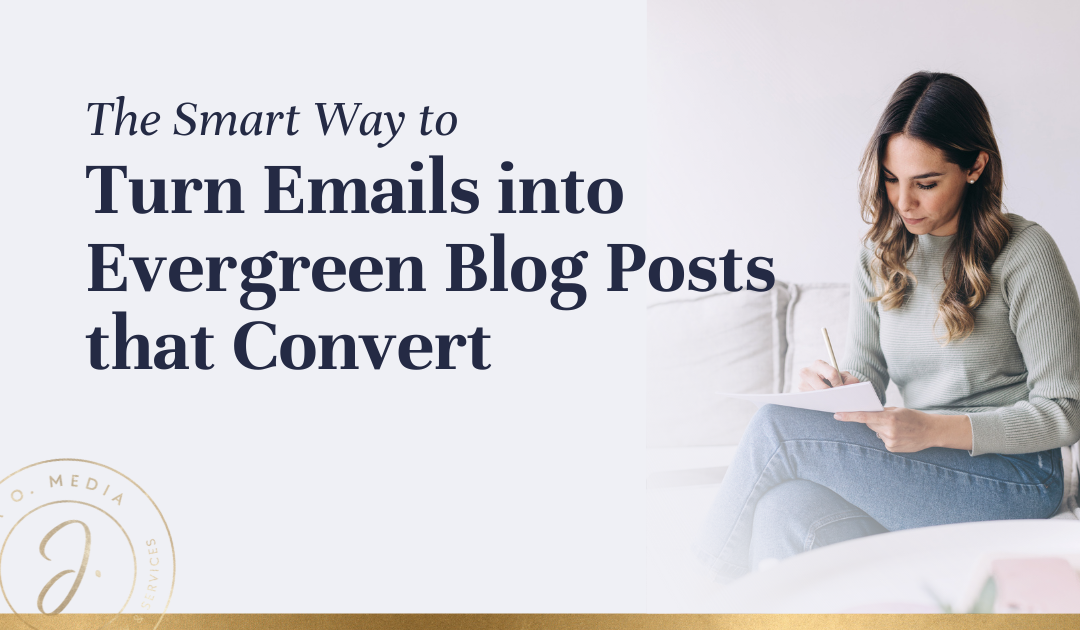If you’ve been running a successful coaching or service-based business for awhile, you’ve probably written so many marketing emails — and many of them are pure gold. ✨✨✨
So naturally, you’ve been thinking about repurposing that goldmine of emails into blog posts, so you can have your best content on your own website.
(Honestly, you can’t believe that you’ve achieved this level in business and yet you *still* don’t have a blog. 🫣 Eeeek.)
But…
When you think about actually turning those emails into blog posts, you feel a bit stuck. So many questions come up…
- Should you keep the email as is? Or heavily rewrite it?
- Are the emails too short to even work as blog posts?
- And then there’s SEO — everyone says it’s critical, but the keywords your SEO person (or your fancy software) gave you don’t seem to fit naturally with what your emails are actually about. 😐
Frustrating, right? You just want to get these insights onto your blog. Why does it feel so complicated?
Well, never fear! I’m here to help you bust through that stuckness. 💪🏼
In this blog post, I’m going to share my best strategies for turning some of those ahhhhhhhhhh-mazing emails you’ve written into high-quality blog posts.
I’m going to cover:
- The smartest way to choose which emails will make the best blog posts
- The process I have my students use when they want to turn emails into blogs
- Whether SEO should be a factor in this process
- If your emails are too short to be blogs, specific ways you can make them meatier
- How I turned one of my marketing emails into a blog post: (Video Walk-through)
- Easy formatting tips for making your blog post easy and fun to read
You can absolutely enjoy the benefits of a blog that showcases your expertise, builds demand for your offers, and makes content repurposing a cinch…
And it can all start with you transforming those marketing emails into awesome blog posts!
Ready?
Okay, let’s start with this crucial question…
How should you choose which emails to use for blog posts?
Not all emails are created equal when it comes to repurposing them into blog posts. That’s why the first step is to figure out which ones to use.
First, you want to first narrow it down to only the ones that are evergreen in nature, because blog posts need to stand the test of time.
Of course, you probably have a lot of timeless emails — so you’ll need some additional criteria for choosing, too.
And, I’m *not* going to recommend that you simply pick your most popular emails or pour over your open rates to choose your contenders. Nope.
Instead, I want you to identify emails that fit with your big-picture content strategy* — and prioritize using the emails that fit that.
(*A content strategy just means that (a) you’ve done the work to identify the key things your audience needs to hear, learn, and understand, to be ready to buy — and that (b)you’re making sure your blog posts say those things.)
So let’s talk about what I recommend for this…
How I recommend my students choose which emails to repurpose:
My High-leverage Content students start by learning my key content strategy framework:
The HLC ‘9-in-2 Content Pillars.’
These pillars outline the essential messages your audience needs to hear, learn, and understand before they’re ready to buy.
This is how we develop a strategic blog content plan inside HLC — so naturally, it’s also how we decide which emails to repurpose into blog posts.
If a student has a large archive of past emails, I recommend she first skims through and tags potential candidates. Then, she compares them to the 9-in-2 pillars and plugs them into her blog topic plan spreadsheet. This instantly reveals which emails will be the best fit for blog posts, per the content strategy she has developed.
The result? A well-rounded blog that balances educational content (which builds trust by teaching and providing specifics) with conversion-focused content (which creates demand and moves readers toward taking action and working with you)…
Both are necessary. If your blog is only educational, you might attract readers who learn from you but never take the next step. If it’s only conversion-focused, you might struggle to build the authority for people to trust you and feel ready to buy. One of the keys to a high-converting blogs is to have a mix of both.
If you’re already an HLC student, this ‘9-in-2’ framework will guide you in selecting emails to repurpose with confidence.
If you’re not an HLC student, you can still take this strategic approach to picking emails:
- Define your blog’s content strategy first. Ask yourself: What does my audience need to hear, learn, and understand more deeply — before they’ll feel ready to work with me?
- Review past emails through this lens. Look for emails that already align with those key topics.
- Map them out. Organize them into a simple plan so you can see how your blog content flows together.
The takeaway? Don’t pick emails at random—choose them with intention!
Okay, and what about SEO though?
Brace yourself. What I’m about to share with you may come as a shock. 🤣
When you’re starting your blog (or re-starting it) I want you to…
Bless and release SEO — for now.
(I know, I know… But trust me!)
Thinking you need SEO out-of-the-gate will, more times than not, slow you down — and often it simply just keeps you from even starting.
I see this happen all the time to coaches and service providers who want to start a blog.
And I *definitely* see this derail people who are trying to turn their emails into blog posts, too.
They search for keywords, trying to find ones that match their existing emails, but come up empty-handed…
They get discouraged and second-guess whether their emails will even make good blogs, since they erroneously think SEO has to be a priority right now.
And then often they abandon the idea of using their emails as blogs altogether.
(Sound familiar? Some of you reading have done *exactly* all those things, which means you’ve still got all those fab emails collecting digital dust, instead of on your blog.)
And that’s not what I want for you!
So, ignore SEO for now.
For your first (or next) 12 blog posts, simply identify emails (in the way I described above) that meet your audience’s key needs… those emails that, as blogs, will build the trust and demand needed to convert them to clients… And use those!
No keyword overthinking required.
And here’s the best part of this plan…
By focusing first on the emails that will make the best conversion-friendly blog posts, you’re still setting yourself up for SEO success later — because Google does reward content that matches the needs of real humans.
BUT… you’re doing it *without* the overwhelm that holds so many coaches and service providers back — and keeps them BLOG-LESS. 😉
PS — Honestly, 99% of coaches and service providers who I know personally who now rank on Google, didn’t start their blog with an intentional SEO plan anyway. (Me included!)
They simply started with writing the things their audience needs to hear, learn, and understand, to be ready to buy. So that’s what I want you to do for now, too. k?
Next up, let me help you with this 👇🏼 burning “email-to-blog” question:
Are your emails too short to even work as blog posts? (And how can you make them longer and meaty enough?)
At this point, you may be wondering,
“Could I just copy and paste the email into a blog post and hit publish? Or is it too short?
The short answer (pun intended):
You could. But it probably won’t be as effective.
Emails and blog posts serve different purposes in your marketing ecosystem. Emails are generally shorter, more narrow in focus, and designed for quick consumption.
Meanwhile, readers generally expect more detailed insights from a blog post.
And you want to give more detail in them, too…
Because blogs are meant to provide more depth, to showcase your more comprehensive and nuanced thought leadership ideas, and to really build that crucial trust factor — all while creating demand for your paid offers.
So, you will likely want to expand and add depth to your emails, so that you end up with blog posts that truly do those things!
Don’t start from scratch, but rather flesh out your emails, so they are meatier.
How? Look for places where you can do / add following:
1. Expand on key points by adding examples, case studies, and/or stories.
- Where can you include examples (real or theoretical) to help illustrate any of your points? Where can you incorporate your own first-hand observations and experiences — what you’ve seen with clients, yourself, or others you’ve helped or observed
2. Incorporate more about your unique frameworks or processes.
- If your email doesn’t yet reference any of your frameworks or signature processes, where can you find places to add them in? If you did touch on them in the email already, can you go into greater detail on them for the blog post?
3. Add in the answers to FAQs that are closely related.
- Ask yourself what logical questions (or even objections!) may naturally come up for your ideal client, based on what they’re reading so far. These can make great “extra” sections of a blog post that covers your topic more comprehensively. (Pssst… I added one to this blog post that you’re reading. Can you spot it? 👀)
Inside High-leverage Content (HLC), my students get lifetime access to two game-changing tools that really help with expanding their emails (or any short content) into satisfying, effective blog posts:
The HLC Strategic Content Outlines: These walk you through exactly what to include in each type of blog post, paragraph-by- paragraph. There is one outline for each of the 9 types of content that I teach you to create (the aforementioned ‘9-in-2 Content pillars!)
➡️ When using emails as the basis for your blog post, you can compare the email content to the elements in the outline and see exactly what needs to be added.
The HLC Thought Leadership Checklist: This is an excellent resource for finding ways and places to expand, go deeper, and incorporate more of your own frameworks, unique perspectives, stories, etc.
Using this checklist when you’re expanding an email will help you make it more appropriate for a blog. And your resulting post will be more high-converting, because it’s more satisfying for the reader (while also whetting their appetite for your paid services!), and it will better position you as the go-to expert in your field.
How I turned an email into a blog post: (Video Walk-through)
Press play on this video if you want to see exactly how I took a marketing email that was well-received and high-converting — and turned it into an evergreen blog post…
Last step to turn your email into a blog post:
Add some light formatting.
After you’ve expanded your post using some of the ideas above, it will now be longer.
(Captain Obvious over here. 🦸🏻♀️ 🤣 )
So, it’s a good idea to break it up and make it more skimmable and readable, with some light formatting.
(Note: I say “light” because I’m a big believer that coaches and service providers do not need fancy blogs. So no need to go crazy here with lots of graphics or widgets, etc… Just the basics.)
Here are some simple ways to do this:
1. Use headings to organize the content.
For example, if your post now lists three strategies, each tip can become its own section in the blog post, with its own descriptive heading.
(Pro tip: I like to use verbs in headings, so they feel actionable. Examples: “Boost Your Workday Energy with These Sleep Strategies” or “Step 3: Test Your Tagline for Maximum Impact”)
2, Put some important phrases and sentences in bold or italics.
(*Here’s a good trick for knowing which parts to bold: If someone starts at the beginning of your post, and only reads all the bold sections, she should still be able to follow your thought process… and get the basic gist of what you wrote.)
3. Add bullets or numbers in places where you’re listing things, when it makes sense.
4. Break up your paragraphs and lines strategically, so you don’t have “walls of text” that look intimidating to read. Try to vary the length of your paragraphs, too.
Incorporating this light formatting will make your piece more digestible and scannable — which is important because people often scan through a blog post BEFORE deciding if they want to commit to reading it. We want yours to feel fun and easy to read!
In conclusion…
I hope you’ve found this post helpful — and that you’ll use these ideas, tools, and strategies to leverage those juicy marketing emails as blog posts.
These strategies will take your emails from quick reads to in-depth pieces of long-form content — and a blog that matches your business’s level of success and makes you so proud!
You’ll end up with a blog that works 24/7 for your business to attract and convert clients, provide detailed answers to common questions or objections, and build trust and demand for your paid offers.
Because remember, the goal is not just to HAVE a blog (although it sure will be nice to have one, finally! 🙂 ) … But to actually have a strategic and high-converting blog.
Ready to build your own high-converting blog?
If you want step-by-step guidance to make blog writing simple and stress-free, plus lifetime access to all the tools I described here, you can enroll in my signature program, High-leverage Content.
Inside, you’ll create a small-but-mighty library of evergreen blog posts that convert clients quickly, and serves as a source of content your team can repurpose across other platforms.
Click on over to learn more:



